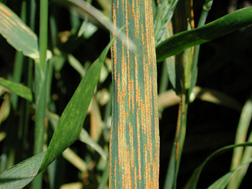This page has been archived and is being provided for reference purposes only. The page is no longer being updated, and therefore, links on the page may be invalid.
|
|
|
|
ARS, Cooperators Discover Wheat Gene with Resistance to Stripe Rust
By Dennis O'BrienFebruary 19, 2009
An international team of researchers that includes an Agricultural Research Service (ARS) expert on wheat biotechnology has discovered a gene that will make bread wheat capable of resisting stripe rust, a fungus that causes crop losses in many states.
Scientists transferred a resistant gene, known as Yr36, from a race of wild wheat into a handful of domesticated pasta and bread wheat varieties. The wild wheat was collected in Israel, a part of the Fertile Crescent where ancient varieties of wheat have grown for centuries, according to Ann Blechl, a geneticist at the ARS Western Regional Research Center in Albany, Calif.
The research was published today in the journal Science by a team that, in addition to Blechl, includes Xianming Chen, an ARS plant pathologist in Pullman, Wash., and researchers from the University of California-Davis and the University of Haifa in Israel. Publication of the gene sequence should give breeders the ability to use sequence-based DNA markers to incorporate resistance into new wheat varieties.
The researchers used a detailed map of a region of one wheat chromosome to isolate a candidate gene sequence. Blechl conducted the team's genetic transformation experiments, transferring the candidate sequence into a susceptible bread wheat variety. Subsequent tests showed the transformed plants were resistant to at least eight races of stripe rust.
Pasta, bread and other foods made with wheat account for about 20 percent of the calories consumed worldwide. But wheat producers have been battling stripe rust in the Pacific Northwest since the 1950s, according to Chen. Severe outbreaks occurred in the South and Midwest in 2000, and three years later the disease wiped out 25 percent of the wheat crop in California.
Caused by the fungus Puccinia striiformis, stripe rust is spread by the wind and is most likely to ruin crops in mild winters, wet springs and wet summers.
The fungus evolves rapidly, developing new races that overcome various race-specific seedling resistances. While it provides only partial resistance to adult plants at high temperatures, Yr36 is useful because it protects against all known strains of stripe rust, making it an effective tool.
ARS is the principal intramural scientific research agency of the U.S. Department of Agriculture.


